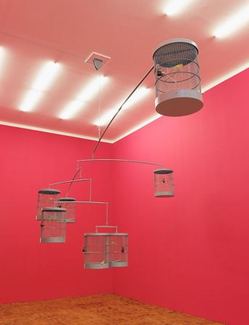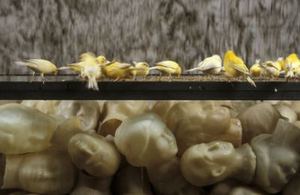 Writing for Art Fag City, Karen Archey is persuasive on the subject of Carsten Holler‘s Vogel Pilz Mathematik at Esther Schipper in Berlin, a “high-budget, in-vogue exercise in industrial design” saved, partially, from the fatally sleek by its “off-putting, saccharinely magenta walls.”
Writing for Art Fag City, Karen Archey is persuasive on the subject of Carsten Holler‘s Vogel Pilz Mathematik at Esther Schipper in Berlin, a “high-budget, in-vogue exercise in industrial design” saved, partially, from the fatally sleek by its “off-putting, saccharinely magenta walls.”
Each of his cages had a canary in it.
Persuasive, yet I was not persuaded. Ordinarily, I am not drawn to Holler. Maybe this piece impresses me because I haven’t stood inside the gallery and instead seen only reproduced images, but a nervous blur of yellow isolated in a cluster of cages appears to animate his chilly geometries without raising their temperatures.
It’s fine to be an iceman, but an iceman voguing on art’s runway is a tough sell for those whose experience with runways is deliberately limited.
Canaries no longer exist in the wild, which isn’t enough of a reason to keep them in cages. (The same could be said of us.) In 1992 at the Henry Art Gallery, Ann Hamilton gave 200 of them the free run of the place. In the show’s early days, they kept having heart attacks. Volunteers hired to tend and feed found a couple dead on the floor each morning. After the shock of the new wore off, the death rate diminished quickly, not quickly enough to prevent animal rights activists from picketing.
I can’t remember what their signs said (Get those birds back in cages?), but the protesters at one point blocked entry to the museum with their bodies. One woman who brought her young daughter and had to step over the prone to get in reported that she was chided by them for being a bad mother.
 To this day, whenever I think of canaries or see one, I think of that show, titled Accountings and curated by Chris Bruce.
To this day, whenever I think of canaries or see one, I think of that show, titled Accountings and curated by Chris Bruce.
Its power came from a metaphorical assumption of
geological time, with the Henry transformed into a blighted hulk.
Entering through smoked glass doors, viewers saw the elegant main gallery
thoroughly undone. Nearly 300,000 metal tags covered the
floor in woozy patterns. Blackened soot covered the walls, smoked by candles.
Canaries flew free. They perched on moldings, hopped around the floor, sailed through the air
and sang. With a long case in the back gallery filled with a jumble of wax
heads made from plaster molds sold in Brazilian churches as amulets
against sin and evil, Accountings functioned as a giant, moldy coat wrapping the audience in its living signs and wax symbols.
Hamilton risked sentimentality. Holler, superficiality. She overcame her limitations, and I have a feeling that Holler did too.



Leave a Reply